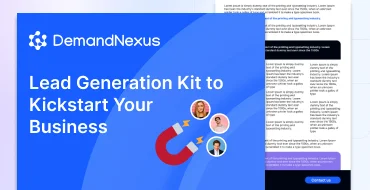Account-based marketing (ABM) engagement is the heartbeat of successful B2B campaigns, fostering deep, personalized connections with high-value target accounts. Unlike traditional marketing, which prioritizes broad lead generation, ABM engagement—sometimes referred to as account-based engagement (ABE)—delivers tailored experiences through strategic outreach and data-driven insights. By leveraging tools like Salesforce, dashboards, and planning templates, businesses can enhance customer relationships, drive conversions, and boost ROI. This comprehensive guide explores ABM engagement strategies, metrics, and best practices, with a case study showcasing how DemandNexus powers ABM success.
What Is ABM Engagement?
ABM engagement refers to the process of creating meaningful, personalized interactions with specific target accounts to build trust, drive interest, and foster long-term loyalty. It’s a core component of account-based marketing, focusing on delivering value-driven content and experiences tailored to the needs of key decision-makers. ABM engagement spans digital channels (e.g., email, LinkedIn) and physical touchpoints (e.g., events, direct mail), ensuring a cohesive customer journey through the ABM funnel.
Unlike broad marketing tactics, ABM engagement targets a select group of high-value accounts, making it ideal for B2B businesses with complex sales cycles and multiple stakeholders.
ABM Engagement vs. ABM: Key Differences
While ABM and ABM engagement (or ABE) are closely related, they serve distinct roles in a B2B marketing strategy. Here’s how they compare:
| Aspect | ABM | ABM Engagement (ABE) |
|---|---|---|
| Focus | Holistic strategy for targeting accounts | Tactical, personalized interactions |
| Scope | Multi-channel campaign planning | Specific touchpoints and content delivery |
| Goal | Pipeline growth, conversions | Building trust, deepening relationships |
| Example | Defining ICP, launching campaigns | Personalized emails, event follow-ups |
![]() ABM engagement is the tactical execution within an ABM strategy, ensuring each interaction resonates with the customer.
ABM engagement is the tactical execution within an ABM strategy, ensuring each interaction resonates with the customer.
Benefits of ABM Engagement
ABM engagement delivers significant advantages for B2B businesses, particularly those targeting high-value accounts:
- Stronger Relationships: Personalized interactions build trust and loyalty with decision-makers.
- Higher Engagement: Tailored content increases response rates, with studies showing up to 60% open rates for ABM emails.
- Shorter Sales Cycles: Engaging multiple stakeholders simultaneously accelerates decisions.
- Increased ROI: Focused efforts on high-potential accounts maximize returns, as noted by Demand Metric.
- Customer Retention: Ongoing engagement post-sale drives upsells and referrals.
Building an Effective ABM Engagement Strategy
Creating a successful ABM engagement strategy requires a structured approach, often outlined in a playbook. Follow these steps to maximize impact:
1. Define Your Ideal Customer Profile (ICP)
Start by identifying your high-value target accounts using firmographic and intent data. Tools like lead research services help define characteristics such as industry, revenue, or technology stack.
2. Map Buyer Personas
Understand the decision-makers within each account, detailing their roles, pain points, and content preferences. For example, a CTO might value technical whitepapers, while a CFO prefers ROI-focused case studies.
3. Craft Personalized Content
Develop account-specific assets to drive engagement, such as:
- Tailored cold email sequences addressing specific challenges.
- Customized LinkedIn posts or InMail messages.
- Industry-specific webinars or demos.
- Personalized direct mail, like branded kits.
4. Select Engagement Channels
Choose channels that align with your audience’s behavior:
- Email: For direct, one-on-one outreach.
- LinkedIn: For social selling and targeted ads.
- Events: For in-person or virtual thought leadership.
- Programmatic Ads: For account-specific digital banners.
5. Align Sales and Marketing
Ensure SDRs and marketers collaborate, sharing insights on account behavior and campaign progress. Use Salesforce to centralize data and streamline handoffs.
6. Leverage Intent Data
Use intent data to identify accounts showing buying signals, such as searches for relevant solutions. This ensures timely, relevant engagement.
7. Monitor and Optimize
Create a dashboard to track engagement metrics and A/B test content to improve performance. Regular reviews help refine strategies for maximum impact.
Tracking ABM Engagement: Metrics and Dashboards
Measuring ABM engagement is critical to evaluating campaign success. Use a dashboard in tools like Salesforce to monitor these key metrics:
| Metric | Formula | Why It Matters |
|---|---|---|
| Engagement Score | Weighted sum of interactions (e.g., email opens = 5, demo = 8) | Gauges account interest |
| Email Open Rate | (Emails Opened / Emails Sent) * 100 | Measures content relevance |
| Website Visits | Visits from target accounts | Tracks digital engagement |
| Pipeline Influence | Revenue attributed to ABM | Links engagement to revenue |
| Conversion Rate | (Closed-Won Deals / Opportunities) * 100 | Assesses campaign success |
Assign scores to interactions (e.g., email reply = 5 points, demo booked = 8 points) and track them in a spreadsheet or Salesforce dashboard for real-time insights.
Case Study: DemandNexus Drives ABM Engagement for a SaaS Firm
A SaaS company offering collaboration tools struggled with low engagement rates, with only 12% of target accounts responding to campaigns. DemandNexus implemented a robust ABM engagement strategy to turn things around.
- Challenge: Poor response rates and misaligned outreach efforts.
- Solution: DemandNexus developed a tailored ABM playbook, using Salesforce to track engagement and intent data to prioritize accounts. They crafted personalized email sequences and LinkedIn campaigns, supported by lead nurturing tactics, targeting IT directors with industry-specific content.
- Results: Engagement rates surged to 60%, pipeline influence grew by 45%, and 6 accounts converted within three months.
DemandNexus’s expertise in ABM engagement, backed by data-driven strategies and tools, helps B2B companies build meaningful connections and achieve measurable results.
ABM Engagement Template: A Ready-to-Use Framework
Use this based marketing plan template to structure your ABM engagement strategy:
- Objective: Define engagement goals (e.g., increase response rates by 20%).
- Target Accounts: List accounts with ICP criteria and intent signals.
- Personas: Map decision-makers and their pain points.
- Content Plan: Outline assets (e.g., emails, webinars).
- Channels: Specify email, LinkedIn, or events.
- Engagement Scorecard: Assign scores to interactions for tracking.
- Timeline: Set milestones for launch and review.
Overcoming ABM Engagement Challenges
ABM engagement faces hurdles like personalization at scale or data accuracy. Address them with:
- Automation: Use tools like Salesforce to scale personalized outreach.
- Data Quality: Leverage intent data for accurate targeting.
- Collaboration: Ensure regular sales-marketing syncs to maintain alignment.
Your ABM Engagement Playbook
ABM engagement is the key to forging lasting B2B relationships that drive revenue. Build a strategy that defines your ICP, personalizes content, and leverages channels like email and LinkedIn. Use Salesforce dashboards to track metrics and optimize performance. With a tailored playbook, your ABM programs can deliver exceptional customer experiences and measurable success. Ready to elevate your ABM engagement? DemandNexus offers expert solutions to craft and execute high-impact strategies. Contact them today to transform your B2B campaigns.



